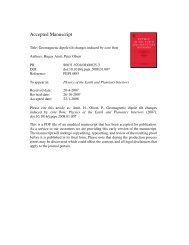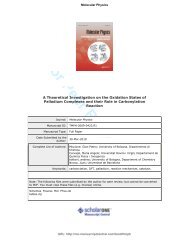1 TREATMENT OF DOXORUBICIN RESISTANT MCF7/Dx ... - TARA
1 TREATMENT OF DOXORUBICIN RESISTANT MCF7/Dx ... - TARA
1 TREATMENT OF DOXORUBICIN RESISTANT MCF7/Dx ... - TARA
You also want an ePaper? Increase the reach of your titles
YUMPU automatically turns print PDFs into web optimized ePapers that Google loves.
Biochemical Journal Immediate Publication. Published on 11 Aug 2011 as manuscript BJ20111333<br />
THIS IS NOT THE VERSION <strong>OF</strong> RECORD - see doi:10.1042/BJ20111333<br />
GSH antibody or with anti H3 antibody obtaining two bands of glutathionylated proteins (Figure<br />
2B). The upper and more intense band which corresponds to the histone H3 showed an increase of<br />
glutathionylation upon GSNO treatment in both sensitive and resistant cell lines as compared to the<br />
control. The lower and weaker band should correspond to the H2B type 2D since it is absent from<br />
the same samples when analyzed with anti H3 antibody (Figure 2B). To exclude any artifact we did<br />
the opposite experiment by immunoprecipitation of same samples with anti H3 antibodies and<br />
further western blotting analysis using either anti GSH or anti H3 antibodies (Figure 2C), or anti<br />
GST P1-1 antibody (Figure 2D), respectively. The results shown in Figure 2C suggested that only<br />
the untreated or GSNO-treated <strong>MCF7</strong>/<strong>Dx</strong> cell lines possess a glutathionylated albeit weak H3 band<br />
consistent with the increase of glutathionylation observed already in these drug resistant cells. The<br />
absence of GST P1-1 in the untreated or GSNO-treated <strong>MCF7</strong> cells (Figure 2D) was expected since<br />
this drug sensitive cell line does not express GST P1-1 (see also Figure 4). Conversely, a strong<br />
band corresponding to GST P1-1 (Figure 2D) was observed in both the untreated or treated<br />
<strong>MCF7</strong>/<strong>Dx</strong> cell lines, suggesting the formation of a complex between histone H3, GST P1-1 and<br />
GSH. The specificity of this immunoprecipitate was tested using PARP antibodies as negative<br />
control (results not shown).<br />
GSNO treatment increased doxorubicin accumulation in the nucleus and reverted the drug<br />
resistance in <strong>MCF7</strong>/<strong>Dx</strong> cells<br />
In drug sensitive cells doxorubicin appeared mainly located in the nuclei while in drug resistant<br />
cells it was located throughout the cytoplasm with the nuclei being almost completely negative for<br />
the doxorubicin fluorescent signal (Figure 3A, control). Exposure of drug resistant cells to GSNO<br />
caused doxorubicin accumulation in the nuclei in a time dependent manner (Figure 3A, lower<br />
panels), while no significant differences were observed in drug sensitive cells (Figure 3A, upper<br />
panels). Cytofluorimetric analysis confirmed that GSNO pre-treatment increased the amount of<br />
cellular doxorubicin in <strong>MCF7</strong>/<strong>Dx</strong>, as compared to untreated <strong>MCF7</strong>/<strong>Dx</strong> cells (Figure 3B). After 24<br />
hours of doxorubicin treatment, about 75% of drug sensitive <strong>MCF7</strong> cells showed morphological<br />
features of apoptotic/necrotic cells, while cell death was almost absent in drug resistant <strong>MCF7</strong>/<strong>Dx</strong><br />
(Figure 3C). Pre-treatment of <strong>MCF7</strong>/<strong>Dx</strong> with 0.5 mM GSNO for 1 hour was able to revert<br />
doxorubicin resistance of <strong>MCF7</strong>/<strong>Dx</strong> cells, leading to a 30-fold increase in the number of<br />
apoptotic/necrotic cells (about 65% of cells), a level comparable to that observed in drug sensitive<br />
<strong>MCF7</strong> cells (Figure 3C). It was obvious that neither doxorubicin nor GSNO alone (data not shown)<br />
were able to trigger cell death of drug resistant cells whereas their combined action was effective to<br />
abolish drug resistance completely (Figure 3D). Cytofluorometric analysis of the same cell lines<br />
shed more light on this phenomenon (Figure 4). In the drug sensitive cells 24 hours doxorubicin<br />
treatment caused a dramatic block in G2/M phase (Figure 4A), while in the drug resistant <strong>MCF7</strong>/<strong>Dx</strong><br />
cells neither 24 hours doxorubicin nor 1 hour/3 hours GSNO treatment alone were able to block the<br />
cell cycle in G2/M phase (Figure 4B). However, when these cells were pretreated with GSNO (1-3<br />
h) and then exposed to doxorubicin for 24 hours we observed that about 80% of the cells were in<br />
G2/M phase (Figure 4B). The ability of GSNO pretreatment to restore the sensitivity to doxorubicin<br />
of the drug resistant <strong>MCF7</strong>/<strong>Dx</strong> cells has also been confirmed by cell viability assay (Supplementary<br />
Figure S2). These results demonstrate again the synergy of nitric oxide and doxorubicin in the<br />
reversal of drug resistance in the <strong>MCF7</strong>/<strong>Dx</strong> cells.<br />
Accepted Manuscript<br />
GSNO treatment of both <strong>MCF7</strong> and <strong>MCF7</strong>/<strong>Dx</strong> cells caused formation and binding of DNDGIC<br />
to GST P1-1<br />
In the cytosol nitric oxide spontaneously forms a dinitrosyl diglutathionyl iron complex<br />
(DNDGIC), which binds with very high affinity, to intracellular GSTs [9-12, 23]. Electron<br />
paramagnetic resonance spectroscopy (EPR) measurements of <strong>MCF7</strong>/<strong>Dx</strong> cells exposed to GSNO<br />
for different times showed the formation of intracellular DNDGIC (Figure 5A); the spectra showed<br />
signal line shapes and positions typical for the complex bound to GST P1-1 [9, 10]. It is known that<br />
6<br />
Licenced copy. Copying is not permitted, except with prior permission and as allowed by law.<br />
© 2011 The Authors Journal compilation © 2011 Portland Press Limited
















